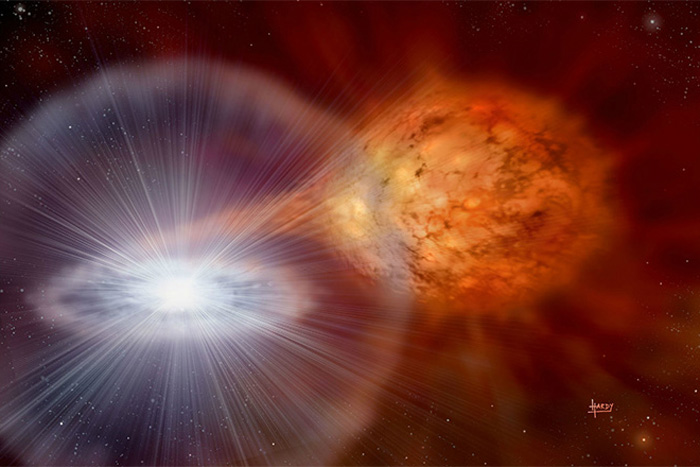Ancient Dust Found in Meteorites Came from Exploding Stars

Microscopic dust grains extracted from meteorites that landed on Earth had ancient and explosive origins, scientists have discovered.
The dust grains — also known as presolar grains, since they're older than Earth's sun — were likely spewed out by stars that blew up hundreds of millions of years before Earth's solar system formed. And in a new analysis of data collected from these tiny particles, researchers have come closer to pinpointing the type of stellar blast that produced the dust, 5 billion years ago.
To trace the origins of the stardust's subatomic "fingerprints," scientists built computer models simulating the explosive conditions that could have produced them, to test whether the dust grains' point of origin might have been an exploding white dwarf star in a double-star system. [Images: Dust Grains from Interstellar Space]
Ancient grains
This study adds to decades of analysis devoted to puzzling out the age and origins of these presolar grains, according to study co-author Christopher Wrede.
Wrede, an assistant professor of physics at Michigan State University, told Live Science in an email that researchers look at the grains' isotopes — variations of an element that have different numbers of neutrons. About a dozen grains held a great deal of the isotope silicon-30, which has been linked to a certain type of stellar explosion called a classical nova.
Classical novas — stellar eruptions that happen in a binary, or paired, star system — are different from supernovas, Wrede said, in that they are a type of explosion that can happen over and over again. The smaller star in a pair, a white dwarf, steals fuel from its larger neighbor, heating up its own surface and eventually blasting dust and gas into space.
"After a classical nova, the white dwarf can continue to siphon fuel from the companion and ignite again," Wrede said. "In a supernova, the entire star explodes, so it can only happen once."
Get the Space.com Newsletter
Breaking space news, the latest updates on rocket launches, skywatching events and more!
Going nuclear
When Earth's solar system was forming, collisions heated and mixed the building blocks of dust and gas, cooking them uniformly so that they shared many of the same isotopes. Grains with unusual isotopes — like silicon-30, which is rare on Earth — stand out, Wrede explained. "This tells us that they must have been produced prior to the formation of the solar system," dating back around 5 billion years, Wrede said.
According to Wrede, the high quantities of silicon-30 compared to other silicon isotopes in the grains suggested that they originated in a classical nova, but he and his colleagues were unsure just how much silicon-30 they could expect to see, relative to the other isotopes, if a classical nova were responsible. Their experiments revealed a new pathway for a nuclear reaction that would affect the amount of silicon-30 produced, and will help determine if the amount of silicon-30 in the dust grains is a match.
"The pathway seems to be a strong one, but we'll need to do more experiments to find out how strong," Wrede told Live Science.
The findings were published online March 8 in the journal Physical Review Letters.
Follow Mindy Weisberger on Twitter and Google+. Follow us @livescience, Facebook & Google+. Original article on Live Science.
Join our Space Forums to keep talking space on the latest missions, night sky and more! And if you have a news tip, correction or comment, let us know at: community@space.com.











